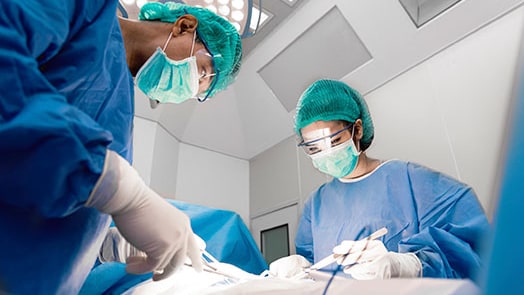Key points
- Necrotizing fasciitis is a rare, but serious bacterial infection.
- It can develop very quickly into a life-threatening emergency.
- Early symptoms include fever, severe pain, and an infection that spreads quickly.
- People with necrotizing fasciitis need immediate hospital care, antibiotics, and surgery.
- Speak with a healthcare provider if you have concerns about necrotizing fasciitis.

What it is
There are many types of bacteria that can cause the "flesh-eating disease" called necrotizing fasciitis. Experts believe group A Streptococcus (group A strep bacteria) are the most common cause. This web page only focuses on necrotizing fasciitis caused by group A strep bacteria.
Symptoms
Necrotizing fasciitis spreads very quickly.
Early symptoms can include:
- A red, warm, or swollen area of skin that spreads quickly
- Fever
- Severe pain, including beyond the area that's red, warm, or swollen
When to seek immediate medical attention
Later symptoms can include:
- Changes in the color of the skin
- Diarrhea or nausea
- Dizziness
- Fatigue (tiredness)
- Pus or oozing from the infected area
- Ulcers, blisters, or black spots on the skin
Complications
Necrotizing fasciitis can lead to
- Organ failure
- Sepsis
- Shock
It can also result in life-long complications from loss of limbs or severe scarring due to surgically removing infected tissue.
Recent data show how deadly necrotizing fasciitis can be. Even with treatment, up to 1 in 5 people died from the infection.
Risk factors
Although it's rare, anyone can get necrotizing fasciitis. Some conditions that weaken the immune system can increase the risk for necrotizing fasciitis.
Other health factors
Most people who get necrotizing fasciitis have other health factors that may lower their body's ability to fight infections. Conditions that weaken the body's immune system include:
- Cancer
- Cirrhosis (scarring) of the liver
- Diabetes
- Kidney disease
Injuries that break the skin
People with an open wound (break in the skin) are at increased risk for necrotizing fasciitis. The bacteria most commonly enter the body through a break in the skin, which can include:
- Burns
- Cuts and scrapes
- Insect bites
- Puncture wounds (including those due to intravenous [IV] drug use)
- Surgical wounds
However, people can also get necrotizing fasciitis after blunt trauma (an injury that doesn't break the skin).
Causes
Group A Streptococcus (group A strep bacteria) cause necrotizing fasciitis.
Most cases of necrotizing fasciitis occur randomly. However, less serious group A strep infections can turn into necrotizing fasciitis and these bacteria are contagious.
Prevention
There are things people can do to protect themselves and others from group A strep infections.
Testing and diagnosis
There are many infections that look similar to necrotizing fasciitis in the early stages, which can make diagnosis difficult. In addition to looking at the injury or infection, healthcare providers can diagnose necrotizing fasciitis with:
- Biopsies (taking tissue samples)
- Bloodwork for signs of infection and muscle damage
- Imaging (CT scan, MRI, ultrasound) of the damaged area
However, it's important to start treatment as soon as possible. Therefore, healthcare providers may not wait for test results if they think a patient might have necrotizing fasciitis.
Treatment and recovery
Necrotizing fasciitis is a very serious illness that requires hospital care. Antibiotics and surgery are typically necessary.
Antibiotics
To try to stop the infection, healthcare providers give antibiotics through an IV, which allows medicine to flow into a vein.
Sometimes, however, antibiotics can't reach all the infected areas because the bacteria have killed too much tissue and reduced blood flow. When this happens, healthcare providers must surgically remove the dead tissue.
Surgery
Since necrotizing fasciitis can spread rapidly, patients often must get surgery quickly. It's not unusual for someone with necrotizing fasciitis to end up needing multiple surgeries. In serious cases, the patient may need a blood transfusion.
